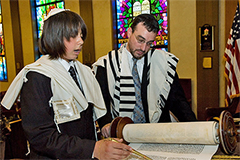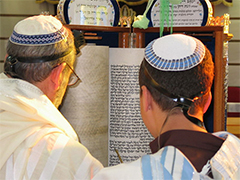ONE TRADITION, DIFFERENT CUSTOMS
The Ashkenazic experience
by Rabbi David Rogut

The source of the bar mitzvah celebration is based on Halacha LeMoshe MiSinai, a tradition handed down by God to Moses on Mount Sinai, that a boy becomes bar mitzvah at the age of 13 years and one day. It later became customary to mark this occasion by calling up the bar mitvah celebrant on his 13th birthday, when he reads the concluding section of the sidra called Maftir. This was an automatic religious elevation to manhood without ceremony. Prior to his 13th birthday, the boy is not called up to the Torah. In later years, the sages added a section from the Prophets called the Haftorah. The bar mitzvah event is marked by a Seudah — religious feast — which is celebrated after reading the Maftir and Haftorah.
The Sephardic experience
by Rabbi Michael Chriqui

In Sephardi tradition, a Bar Mitzvah celebration is often referred to as “Tefillin” ie. the laying of tefillin which the Bar Mitzvah boy would do publicly by singing out the Shema and Kadesh-li with great celebration. A meal is held right after the laying to accentuate the joy and importance of the actual mitzvah observance of tefillin, which will be practiced daily for the rest of his life. It is customary that the grandparents, the father and the uncles of the boy are each honoured with winding the tefillin straps around his arm. It is a custom of many Sephardim that the Bar Mitzvah boy is called up to the Torah at the first opportunity (ie. Monday or Thursday where applicable as well as Shabbat). As the boy is called to the Torah, “Piyutim” songs are sung in his honour. The Bar Mitzvah is celebrated for a few days, including the day of tefillin laying, on Shabbat and on Motzei Shabbat when the boy gives a Torah talk. Generally the boy honoured on this day, and is escorted to the synagogue by relatives, guests and friends.
The Chabad Bar Mitzvah
by Rabbi Zalman Kastel
Bar Mitzvah celebrations at Chabad reflect an emphasis on preparation for life after the event. The boy or girl will have spent at least a year learning with a Rabbi or Rebbetzin including insights of Jewish mysticism, which gives them a rich understanding of Judaism and Mitzvot. The Bat Mitzvah is a meaningful ceremony with the B’not Mitzvah presenting their own insights, including mystical dimensions along with primary traditions. Bar Mitzvah boys explain the Torah portion and Haftorah, and are encouraged to demonstrate their ability to participate in a Shabbat service by leading a portion of the service.
The Reform Bar/Bat Mitzvah
by Rabbi Richard G Lampert
Boys and girls who wish to celebrate becoming reform Bar/Bat Mitzvah are required to attend Hebrew and religion school classes twice a week for a minimum of two years. This is to prepare themselves for their lives as Jews and their role in the service. A year before the B’Mitzvah they are also required to attend lessons and services every Shabbat morning. During the service, every child conducts the statutory sections of the service (mainly in Hebrew), reads or chants 30-50 verses of the Sedra and the Haftarah in English and if possible in Hebrew. There is no difference in the ceremony between boys and girls — the girls do whatever the boys do. The parents are involved in the service by placing the Tallit around the child’s shoulders in a specially designed Tallit ceremony and by both parents and other family members being called to the Torah during the Torah reading. The entire family is then called up to the Bimah for a family “Mishe’beirach”. Finally, the child reads a B’Mitzvah prayer in front of the Ark and is blessed by a Rabbi.
One outstanding Bar Mitzvah
One outstanding bar mitzvah of last century would have to be that of a Russian boy named Nicolai Krohn. In 1941 at the Leningrad train station, Krohn encountered American engineer Joseph Levinson. An American technical expert sent to assist Russian industry and railroad, Levinson was being evacuated from Leningrad. Krohn was travelling to commence studies at the state (Communist) school in Vologda. Krohn’s aunt, who was farewelling him, assumed that Levinson was Jewish and probably had Jewish education. She also appreciated that he would be travelling for several hours on the same train as her nephew.
She implored him to convey to her nephew all that he knew about Judaism as he was turning 13. In their cabin, an American who knew very little of his own heritage was able to arouse a young man’s interest in his Jewishness. In fact, that journey became a turning point in Nicolai rohn’s life-long search for Jewish meaning. Krohn took Levinson’s challenge seriously and went on to study Hebrew, later becoming a refusenik who was imprisoned for applying to go to Israel. While in prison, he inspired other Jewish prisoners with a love of Torah and Hebrew. Eventually, Krohn was granted permission to make aliyah and he currently lives in Jerusalem with his children and grandchildren.
Sadly, there are too few bar mitzvah boys today such as Nicolai Krohn for whom bar mitzvah is a turning point in their life. Bar mitzvah often becomes a ritual devoid of content. However, an analysis of the origins of bar mitzvah reveals the inspirational dimension to this ceremony that we must attempt to recover.
The Mishna (Ethics of the Fathers, 5:21) states “At age of thirteen one is obligated to observe the mitzvot”. What is this statement’s biblical basis? The commentators derive this from a biblical verse in Bereishit (34:25), which states of Shimon and Levy, the sons of Jacob and brothers of Dinah, that “each man took his sword in his hand”.
In this episode, Dina the daughter of Jacob, was being held by the Canaanites. These two young men, her brothers, were reacting to the capture of their sister. It was their outrage that led them to take their swords and set out to rescue their sister. The Sages calculate that these young men were 13. Since the verse specifically describes each lad as an ish (man) and because we know that they were 13 at the time of this episode, the Sages conclude that this is an indication that manhood is reached at age 13. What is problematic about this derivation is that there are countless other verses in the Torah in which the word ‘ish’ or ‘adam’ are used and where the age of 13 does not apply. Why is it that the Sages chose this episode to represent maturity?
The Sages are teaching us something deeper. The word ‘ish’ is chosen from this episode in Bereishit, as these particular circumstances encapsulate the very essence of maturity in Jewish thinking. By choosing the word ish as it appears specifically in this episode, our Sages are pointing out that this is the essence of maturity and what bar mitzvah is all about. It was Shimon and Levy’s state of outrage at an injustice (their sister’s capture) and their refusal to accommodate assimilation, intermarriage and the suppression of Jewish dignity and pride that motivated their actions. Their actions showed that they were no longer young boys who passively looked on.
When youth act out of conviction, when the continuity of the Jewish people becomes a matter of deep concern, they then merit the term ish that acknowledges their maturity. When our youth refuse to sit by and follow the trends towards assimilation, when they are prepared to stand up and be counted Jewishly and act according to what they know to be correct behaviour, then we know that bar mitzvah has been a turning point in their lives. This is a meaningful bar mitzvah!
Finally, two pleas. The first is directed to bar mitzvah teachers and the second to bar mitzvah parents. I recall at the time of my own bar mitzvah that the late Rabbi Israel Porush, Chief Minister of the Great Synagogue, asked all bar mitzvah boys whether they had yet purchased kosher tefillin and if they intended to put them on every day. When the boys invariably explained that their morning schedules involved early morning travel to high school which would preclude synagogue attendance, Rabbi Porush asked them to commit to a mere five to eight minutes daily at home for laying of tefillin and recital of the Shema before starting the day.
Bar mitzvah teachers must be realistic about the agenda they adopt for boys. At the same time they must be sure to demand a minimal daily commitment to such mitzvot as tefillin. They must explain the meaning of such mitzvot and at the very least, the content of the Torah portion they are teaching. And now my plea to bar mitzvah parents: “Hand-me-down tefillin” send a terrible message to your children. When a father tells his son “Here, you take my tefillin, I no longer need them”, he is communicating that mitzvot are to be discarded with maturation, a message absolutely antithetical to bar mitzvah. I believe that these steps are absolutely essential. If we fail to teach mitzvah observance we are inviting a situation in which our children will one day turn to us and say “Why did you not teach us, correct us, direct us and show us the paths of the Torah and its mitzvot?” Let’s put the mitzvah back into bar mitzvah and get some real nachas from our children.
This article republished with thanks to the Australian Jewish News


